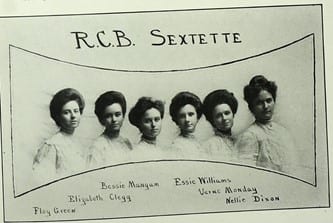Our Sharing Student Scholarship blog posts showcase original scholarship written by Baylor students who conducted research using primary source materials in The Texas Collection. This post is the second of five in a series of blog posts written by graduate and PhD students from the Fall 2018 Foundations & History of Higher Education Leadership course.
by Rachel Jones, Rachel Ticknor, Rachel Henson, Jillian Haag, and Lela Lam
Following its merger with Waco University in 1886, Baylor University set forth a series of initiatives that were progressive in terms of extending college access to various student groups-specifically to women and transfer students. These initiatives included Baylor’s promotion of coeducation and the university’s establishment of formal articulation agreements with Texas high schools and other Baptist colleges. Because of these efforts, a Baylor education had become more accessible to a wider network of students. However, despite these progressive strides, some students (mainly female students) still faced inequality and a lack of access to certain resources/activities once they actually matriculated on campus.
With the establishment of the Baptist General Convention of Texas (BGCT)’s Education Commission in 1897, Baylor focused on leveraging the Commission’s existing partnerships in order to create formal articulation agreements with the other correlated Baptist colleges. Under these agreements, students that completed a standardized two-year curriculum and graduated from the affiliated colleges could transfer to Baylor, without an entrance examination, in order to complete their four-year degree. Baylor utilized a similar model in order to establish formal articulation agreements with a variety of high schools. These two initiatives collectively increased access for, and enrollment of, students who graduated from the affiliated high schools and colleges.
Despite their successes, it is possible that some of Baylor’s most groundbreaking initiatives were inherently exclusionary towards students who did not belong to/identify with the parameters that had been established (e.g. students who did not attend the affiliated high schools or colleges). Moreover, Baylor did not ensure that all students would receive equal levels of access to campus resources and programs once they actually enrolled at Baylor, which resulted in a sense of tension among the university community.

This tension is perhaps most evident in the experiences documented by Baylor’s female students and faculty members between 1900 and 1910. Although Baylor had taken a rather progressive stance on coeducation and allowed men and women to meet in the classroom and in the chapel together, women still faced unfair treatment in terms of housing policies and educational, financial, and extracurricular opportunities. Two examples of this treatment are evident when one takes a closer look at the student literary societies and faculty job opportunities.

As with most topics regarding student access during this time, the issue of women’s participation in literary societies was complex. There was collaboration and partnership between the male and female societies, but this did not always result in equality for their respective members. Though there were a number of benefits that came from women’s membership in literary societies, it is evident that when compared to their male counterparts, female students who chose to participate in such societies faced marginalization. This marginalization is especially evident when one considers the limited opportunity for scholarships.
In a similar vein, female faculty members at Baylor also experienced inequality. Although Baylor had taken a progressive stance on hiring more female faculty members, women comprised less than half of the faculty, were paid less than their male counterparts, and were generally considered lower-level “instructors” rather than full professors. In addition, Baylor rarely hired married female faculty members, notwithstanding that the majority of male faculty were married. All of these examples confirm that Baylor female faculty members faced inequality that was similar to what Baylor female students faced.
As progressive as Baylor was in 1900 to 1910, it was still a far cry from the experience that Baylor women have today. Finally, as Baylor continues to extend access to a variety of students, the university should build intentional partnerships whilst remaining mindful of any possibilities of exclusion.






